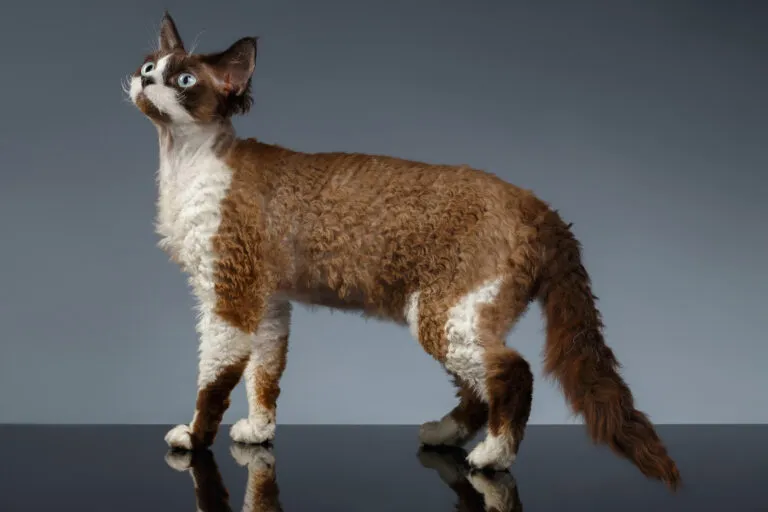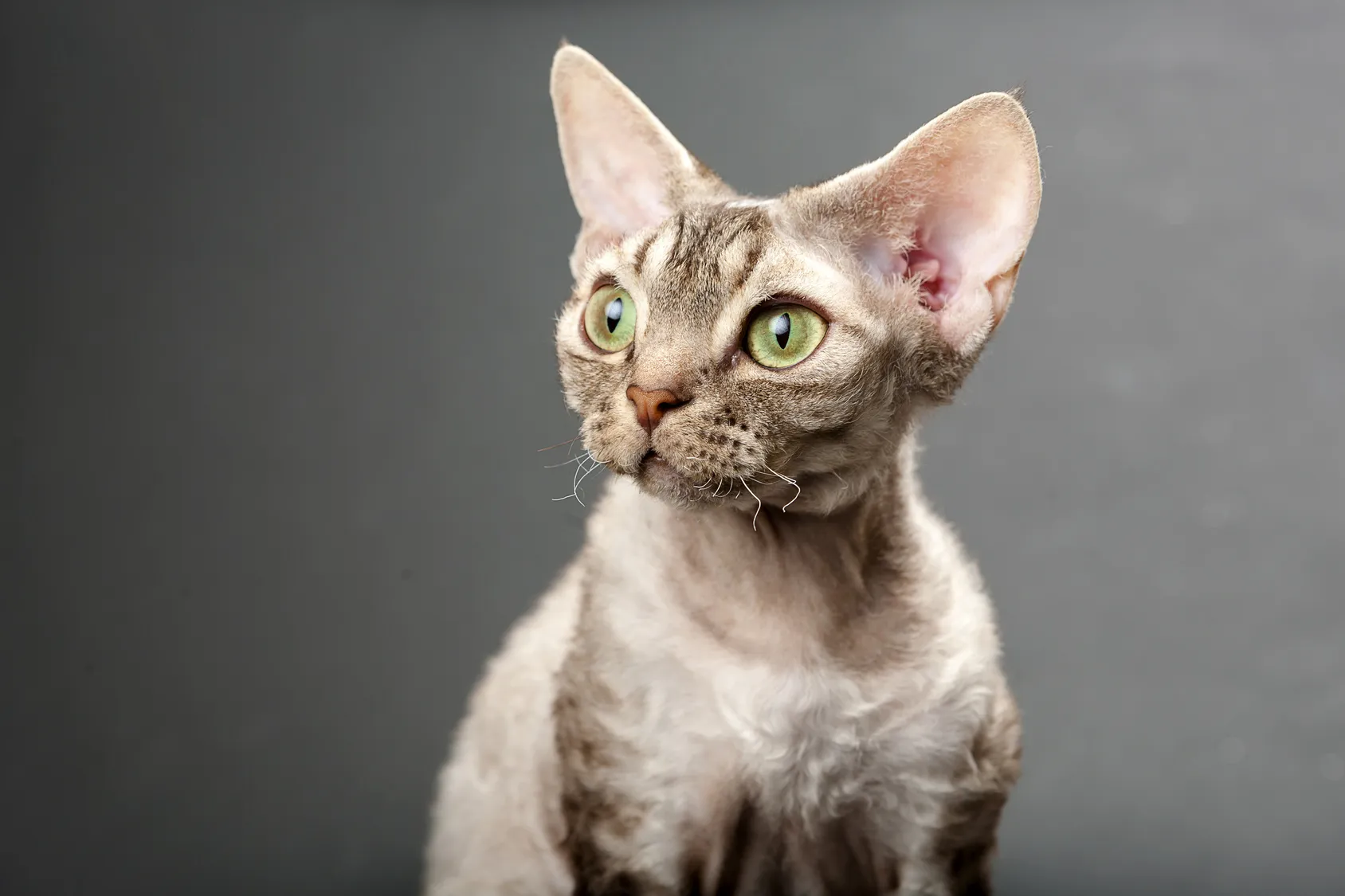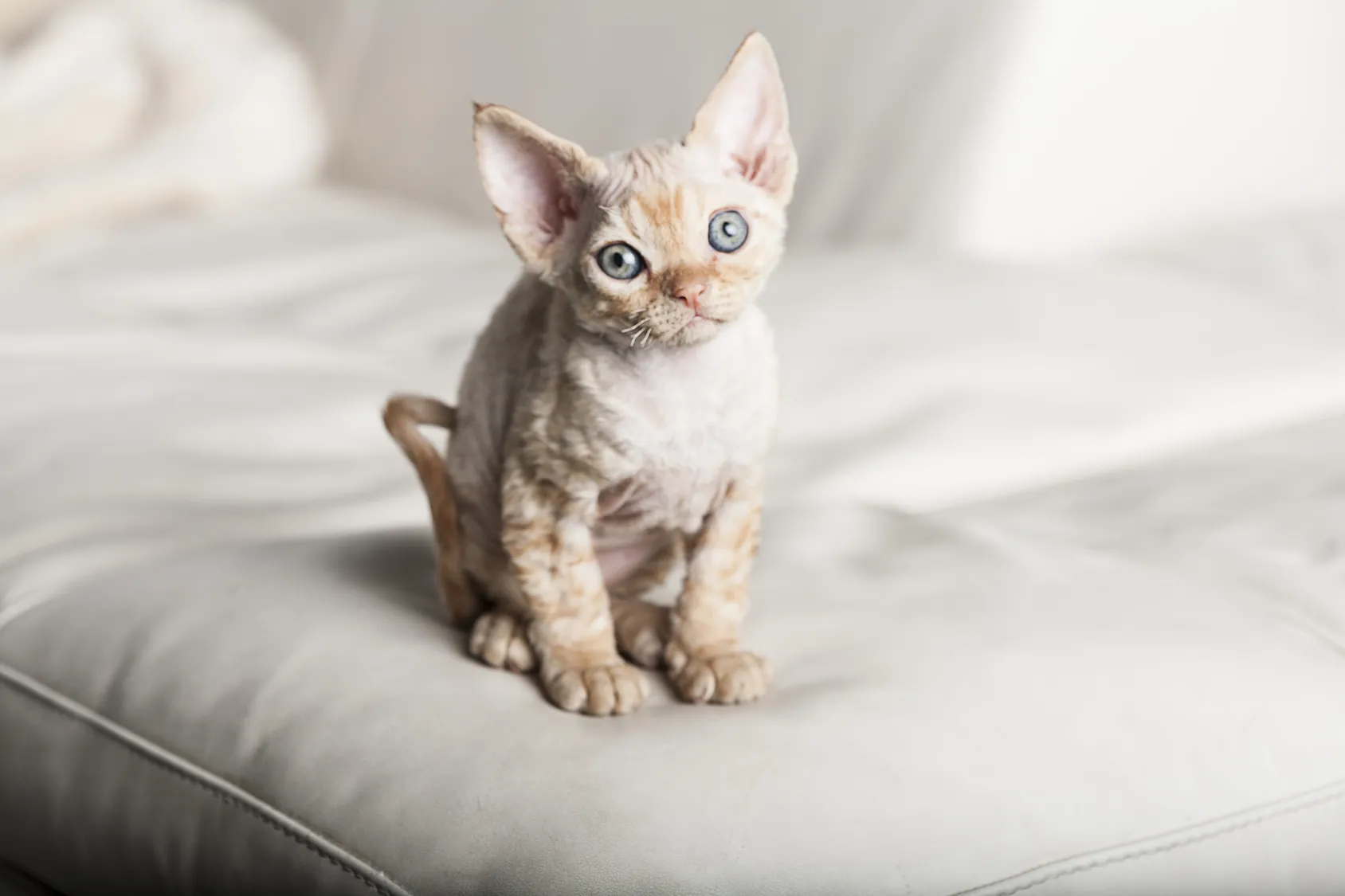Maine Coon
The Maine Coon has now become one of the most popular cat breeds in the world and is enjoying increasing popularity in Ireland, too. This is probably thanks to its authenticity, robustness and excellent character.
The Devon Rex is a rare cat breed that can easily be distinguished from others thanks to its appearance. It was bred to have a flat skull shape with extremely large protruding ears and very big eyes. Whilst initial reaction to the Devon Rex was lukewarm, it later gained approval due to its very special physical features. Since 1968, these special cats with an unusual appearance have been recognised by the “Féderation Internationale Féline” (FiFe). Because of its pleasant character, the Devon Rex is a typical family cat and is also very well suited for being kept in an apartment. Perhaps you will soon make one part of your own home?

© seregraff / stock.adobe.com
The relatively short fur of these cute exotic cats is wavy, almost curly. It has a crimped texture with little top hair and a lot of undercoat. The thickness of the fur varies depending on the area of the body and the season too. A genetic mutation is responsible for the fur’s special texture. The gene is known as krt71 (keratin). There are different answers as to whether the Devon Rex is hypoallergenic. Without doubt, they lose very little fur, therefore the probability of them triggering an allergic reaction amongst their human housemates is low.
With their large ears and wide skull, they somewhat resemble an imp. The Devon Rex’s long thin tail narrows at the tip and is covered with short wavy hair. The medium-length, crimped whiskers are relatively strong. Devon Rex cats have long slim legs and small oval-shaped paws. The slight curvature of the legs relative to the body can give the impression that the Devon Rex has bowlegs. Devon Rex cats come in many different colours and patterns.
 © aylabaha / stock.adobe.com
© aylabaha / stock.adobe.com
Its loyal, affectionate and cuddly character makes the Devon Rex ideally suited for families. It is jolly and fun-loving, playful, relaxed and sociable. It is very curious about everything and loves having fun. Thanks to its playful nature, the Devon Rex also enjoys learning tricks. It is fairly similar to a dog in terms of its nature, since it is very loyal and people-loving. Loyalty was established as a character trait for the first time with a small male cat called Kirlee – find out more about him in the “History and breeding” section. According to legend, Kirlee, the progenitor of the Devon Rex breed, even liked going for walks on a lead. Perhaps he observed this behaviour from a dog.
The Devon Rex makes its human housemates very much its own people. If you’re fortunate enough to share a home with a cat of this breed, it will probably eat and sleep together with you and rest on your shoulder whilst you’re working. The Devon Rex follows you at every turn, sits at your feet or on your lap and even accompanies you doing chores. Of course it doesn’t attempt to do the hoovering itself, but it does try to jolly you along and offer mental support by making funny noises. As you can see, you will always enjoy fantastic company and top-level entertainment with this cat!
The Devon Rex fundamentally gets on very well with children in the household. The Devon Rex loves playing with its human housemates and forges a deep connection with them. It also enjoys rampaging boisterously and climbing up scratching trees, so one or more should be available. As much as they like to be entertained by their human companions, they are also self-sufficient and can keep themselves well occupied.
This curious cat breed with its unusual fur mutation was discovered in Buckfastleigh, Devon in 1960. A British lady called Beryl Cox found this interesting looking cat. The fur colour was tortoiseshell on white. Beryl Cox liked this unusual look and wished to capture the cat for breeding purposes, although this didn’t prove successful.
Instead, things panned out differently. One day, the pregnant cat trudged onto Beryl Cox’s property and gave birth in her garden. To great surprise, the breed also produced a male with wavy hair. Mrs Cox was quite taken by this impish little cat and named him Kirlee. Kirlee had a particularly wide head and his cheeks stood out prominently. With his black curly fur, Kirlee became the progenitor of all the Devon Rex cats that followed.
Mrs Cox then made contact with Mrs Sterling Webb, the first breeder of the Cornish Rex, resulting in Kirlee being paired with the daughter of a male Cornish Rex. The subsequent litter was awaited with great curiosity, but nature is known to not cooperate as humans would imagine. Things turned out very differently and all the kittens in the litter had smooth fur! Thus, it was clear that Kirlee must have had a different genotype. This was a new type of Rex cat and was known as gene 2 (Devon Rex), whilst gene 1 represented the Cornish Rex.
The gene responsible for curly hair results from recessive heredity. This means that although the gene will always be handed down by the parent with curly fur, the kitten will only itself have curly fur if both the parents do. Hence, no kittens with curly fur resulted from pairing Kirlee the male with a smooth-haired cat.
 © aylabaha / stock.adobe.com
© aylabaha / stock.adobe.com
Ensure that there are always sufficient water points available in your house where the Devon Rex can take in refreshment. It’s important that the water bowls aren’t right next to the food bowl. In the outdoors, cats consume food and water separately, since water could become contaminated by meat. Drinking fountains are recommended, since they improve your cat’s drinking habits by constantly encouraging it to drink water. This prevents urinary tract infections and supports healthy renal function.
Since gum disease and tooth decay can emerge for the Devon Rex as it gets older, a feeding method that takes this disposition into consideration is recommended. You can prevent the problem with dry food. This is important amongst other reasons because diseases affecting the teeth and gums can spread throughout the cat’s entire organism, leading to severe ailments such as problems with the kidneys.
A small amount of high-quality fat is also an important component of an ideal diet. Your trusted vet will give you expert information on this matter.
It should be self-explanatory but in some cases still needs to be mentioned: dog food is absolutely not suitable for cats and should not be given to our feline friends!
The Devon Rex will probably insist upon trying to convince you to give it food regularly. However, you shouldn’t succumb to this temptation and should stick to the recommended quantities, because otherwise your cat could suffer from weight gain with negative side effects. As well, a slim appearance is simply characterful for this cat breed with special beauty. As sporty and active animals, they have a high metabolic rate and quickly work off excess calories. The high metabolism can be linked to the fact that the Devon Rex’s body temperature is 1°C higher than that of other cat breeds.
Grooming these cuddly impish cats is largely straightforward. All that the Devon Rex asks for is a loving and lively home. In order for it to stay healthy in the long-term, you should merely take into account a few breed-specific factors.
When brushing the fur, you should always be slightly cautious so that you don’t mistakenly tear out your cat’s hair. You should ideally use a very soft cat brush, with which you can carefully brush your feline friend several times a week. Along with strengthening the connection between the two of you, this also encourages good circulation and healthy fur.
Since the self-cleaning effect is omitted in the absence of hairs in this cat breed’s ear canal, it’s advisable that you regularly clean your cat’s ears yourself.
You should also absolutely ensure that the Devon Rex is adequately protected from the harmful effects of sun rays due to its thin layer of fur, which means that it has a tendency to develop sunburn.
First of all, you can ask an animal shelter if they have any Devon Rex cats looking for a loving home. You could be lucky enough to procure a pedigree cat there.
Otherwise, you can obviously turn to a responsible breeder too, who will be able to share information with you on the cat’s family tree – they should be recognised by world organisations.
As well, kittens should be from a legal, verified breed registered by the veterinary inspection office. Of course, kittens from responsible breeders also have a vaccination certificate and have been microchipped, dewormed and have undergone necessary vaccinations.
The Maine Coon has now become one of the most popular cat breeds in the world and is enjoying increasing popularity in Ireland, too. This is probably thanks to its authenticity, robustness and excellent character.
Neva Masquerade – a mysterious name for a mysterious thing of beauty! The Neva Masquerade is the point variation on the Siberian cat and shares many characteristics with this breed.